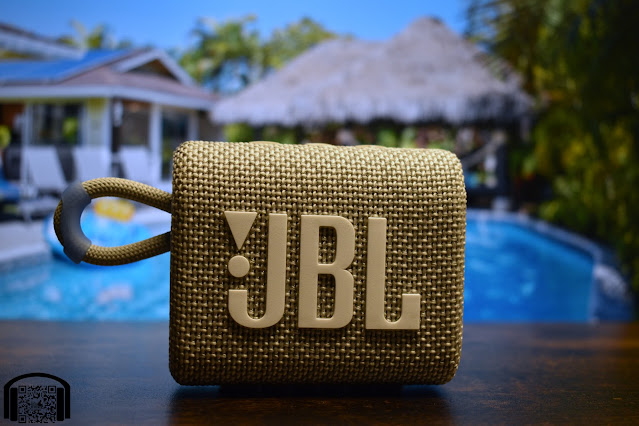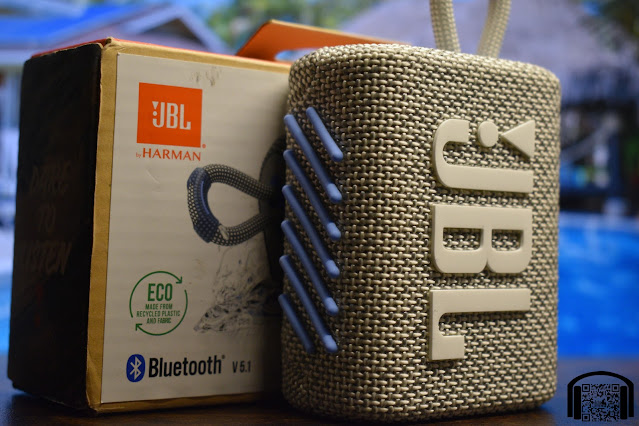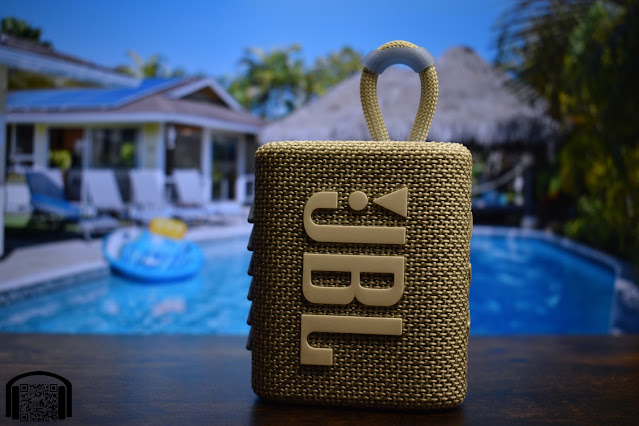TLDR version on YouTube: TDLR - JBL Go 3 Eco
The JBL Go 3 Eco has been sent to me on loan directly by JBL, or rather Harman, here in Spain. While there have been no requests regarding my review itself, they have stipulated that I get to spend 14 days with the device before it is returned.
The JBL Go 3 Eco is available from just about any store, online or offline, that sells tech. As I don’t use affiliate links anyway and JBL themselves won’t really care who you buy it from, just put “JBL Go” into the search bar of your choice and I am sure you will get plenty of options to buy it from wherever you prefer.
Intro…
You might find it a little strange that I am reviewing a Bluetooth speaker, in fact, it is the first review of a speaker that I have posted on Acho Reviews. I mostly focus on earphones and their related products but that has been mainly because I haven’t had space to set up demo sets of speakers until recently (well, the studio is actually still not ready), so maybe I will take a look at some speakers in the near future.
Although all of that is a moot point, as the Go 3 Eco needs absolutely no space to set up, it is smaller than my wallet! Probably lighter too, although that is certainly not due to the amount of cash I have in it!!
The reason that I am reviewing this small bluetooth speaker is that JBL very kindly offered to send it to me to check out and I already have the JBL Go 3 (the non-eco version) which has lived in my bag for quite some time. There are many times when I will find myself with a small group of friends or family and we just want to have some music on, so out comes the Eco 3 as there is nothing I hate more than the tin can sound of music playing from phone speakers (please take note those of you that wander around blasting Reggaeton from your phone and ignoring what others may or may not think).
The Go 3 Eco is priced at under 40€, which is not the cheapest option as far as small bluetooth speakers go but there are other plenty more expensive options out there and I really do feel that the quality you get from this little speaker is more than worth its cost, both in sound and build. I have a few other JBL Bluetooth speakers, one of my favourites being the Charge 3, which lives in my shower, and I have tried quite a few more. The conclusion that I have reached is that their BT speaker range is a great option when you just need something simple to use that provides enjoyable musical performance and is tough enough to just throw about.
With that said, let’s get into the Go 3 Eco and start by mentioning the differences between this and the previous, non-eco, model.
JBL Go 3 Eco vs JBL Go 3…
In short, these are basically the exact same speaker with just one difference between them.
The difference resides in the build of the Eco version. The name Eco comes from the fact that the materials used in the build and packaging are Eco friendly. The plastics used are 90% recycled, the material used for the fabric weaves on the speaker grille are 100% recycled and the packaging is also Eco friendly, certified by the FSC. This is something that I applaud and it is great to know that this is being done without the huge increase in price that some other companies charge for a similar thing. I paid around 28€ for my JBL Go 3 quite some time back and it was on a flash sale at the time. I seem to remember that the normal price was around 35€. Prices have increased on just about everything since then, so I don’t find 40€ (often available for less) to be unreasonable.
Apart from this difference, the rest of the speaker is identical between the Go 3 and the Go 3 Eco, so, for those of you that don’t have experience with the Go 3, let’s talk about what you get and how it performs.
Presentation…
As I just said, the packaging is Eco friendly and the box has that brown look to it that we automatically associate with recycled. On the top we get a sticker showing the device, along with the brand and model etc. A few specs and more images on the back and sides complete the packaging, which is kept simple but functional (i.e: it protects the device in shipping, as I received this one in a simple courier bag).
Opening the box presents us with the speaker, underneath which we find a USB-A to USB-C cable for charging, a quick start guide and the product warranty/safety booklet.
That is it as far as packaging and contents.
Build and aesthetics…
While the materials used for the build are Eco friendly, to the naked eye there is absolutely no difference between the two models. As my Go 3 is black and the Go 3 Eco I have been sent is grey, I can’t say if there are colour differences between them due to materials but honestly, I am not able to note any changes in build between the two.
Obviously I have only had the Eco version for a couple of weeks, so I can’t say if the materials will be any different long term to those of the normal version, however, if they are as resistant, then this little speaker is almost bombproof!
My Go 3 has been in the pool (literally), in the shower, on the beach, in the countryside and just about anywhere I have been. It has been dropped, sat on, stored without protection in a bag with stuff banging against it and basically just thrown around in general, without any signs of wear at all! Yes, the rubber feet are a little dirty but apart from that, it still looks new.
I am sure that the grey finish of the model I have been loaned will show signs of dirt quicker than the black but it is a very nice colour (I prefer it to the black to be honest) and if the toughness is anything like mine, along with the IP67 rating, dirt will probably be your only worry.
The speaker has rubber feet on the bottom for using it upright and a rubber pad on the back for laying it down, but even the JBL logo on the front is of rubber, which adds to the protection whenever it falls (or rather gets pushed) on its face.
The dimensions are approximately 9x7x3.5cm, which means it will easily fit in a pocket or bag (it is about the same size as a lot of my IEM cases that I use) but it also has a loop of cord on one side that allows you to hook it to the outside of a bag with a carabiner, or just about anywhere else you would like.
Really, the build of the Go 3 is one of the things that makes it a great speaker to always have with me and mine has quite a few thousand kilometers of travel on it.
Functionality…
Something like this should be simple to use and it is. On one side you get a USB-C connector which is for charging and on the other side you get a power button and a bluetooth pairing button, with a white LED between them.
Pressing the power button obviously turns it on and you are greeted with the typical guitar sound that all JBL BT speakers make. A quick press of the Bluetooth button puts it in pairing mode (with a tone every couple of seconds, along with the LED flashing to let you know you are in the pairing mode) and a tone tells you once it is connected. I did have to erase my other Go 3 to be able to pair this one but pairing is very fast and once paired, turning it on connects it almost instantly.
On the top of the speaker you get another 3 buttons: a minus symbol, a play symbol and a plus symbol. The + and - are to increase or lower the volume, whereas the play button will play or pause with a short press and also skip the track with a longer press.
Charging the speaker takes around 2.5 hours from empty to full, which only provides around 5 hours of play time (depending on your choice of both music and loudness). However, the Go 3 Eco does work while charging, so you can always have it hooked up to a power bank if you need it to last longer.
Sound…
Let me start by being very clear, the Go 3 Eco (and of course the Go 3) is not a speaker aimed at audiophiles. This is not something that is designed to give you a perfect linear response with great bass extension and extended high treble that bathes in detail and stereo imaging. This speaker is designed to be fun and provide listenable music in a device that will fit in your pocket.
There are obvious limitations to a speaker of this size (and price), starting off with the fact that it is mono. In other words, you are not going to get any sensation of stereo imaging because there isn’t any. This is true with other models of JBL BT speakers that use multiple drivers but are still mixed down to mono (which i why I am a fan of the Charge 3, because it is a stereo speaker), yet in the case of the Go 3 Eco, it uses a single 1.5” dynamic driver with a specified power of 4.5W RMS.
The speaker used, along with the size of the device, is obviously going to have an effect on the low end and, although frequency range is stated as 110Hz to 20kHz (without stating at what +/- dB level), I find that there is a very noticeable roll off that starts around 140Hz. However, between 200Hz and 300Hz, there is a little bit of elevation to the response, which fills in that low end and avoids the sensation of the JBL being tinny and lacking in bass. You are obviously not going to get those low rumbling subbass notes, but the midbass does boost the harmonics of them, so they are not absent.
If you play a bassy track, with the volume turned up to loud, then you will hear the Go 3 starting to struggle, yet it performs much better than can be expected for a 40€ speaker of this size.
One thing I find amusing is that, if you lay the Go 3 on its back and turn up the volume, the bass will make the speaker move around on the table to the beat. It doesn’t help the sound quality though, as you get the vibration noises, so I recommend using the speaker in its upright position.
The midrange and upper ranges, at least up until we get into the higher treble, are very respectable and music has a fun presentation to it. I do not find it to be harsh at all, yet it is clear and all kinds of music can be enjoyed through this little speaker. Again, there are limitations, don’t expect to be picking up on miniscule details and hearing things in music that you have never heard before, but it is far from sounding irritating (which a lot of other small BT speakers do).
The upper ranges start to fall off as we get up towards the 10kHz range, which I find actually works in favour of the little Go 3, as it stops it from being overly bright in those ranges and creating that “tinny” sound that I mentioned earlier.
Conclusion…
I am a huge fan of the Go 3 and the Eco is exactly the same but more caring towards the planet. I have tried a lot of portable BT speakers and I keep coming back to JBL in each of the size categories. They may not be a HiFi reproduction of music but they perform very well for their respective sizes and price ranges.
In general, taking into consideration all of its limitations, the sound of the Go 3 Eco fits well into any small group situation, where you are not looking to fill a room full of people but more towards having a concentrated source of enjoyable music. Again, you are not going to choose it to dissect the latest performance of a Philharmonic Orchestra, but that is not what it is designed for, it is designed to be fun.
Yes, there are a lot of better sounding speakers out there but as soon as we factor in the size restraint, the toughness of the build, and the price, I think the JBL Go 3 Eco is the option that sits above the rest.
If you already have the Go 3, like I do, then I see no reason to purchase the Eco version (unless you want another one) as the plastics have already been used on the one you have, so the damage is done. Yet, if you are thinking of picking up a new one, you are getting a great little speaker that is also trying to do its bit for the planet, something I wish all companies would do.
As always, this review is also available in Spanish both on my blog (www.achoreviews.com) and on YouTube (www.youtube.com/achoreviews)







